How a dark vision of Robin Hood inspired a competitive heist game
A big interview.
"I'm gonna cut your heart out with a spoon!" Ahh, Robin Hood, ahh, Alan Rickman. This is a legend we've seen reinterpreted time and time again for the small and big screens. And now, Robin Hood is the inspiration for Sumo Digital's new game.
Hood: Outlaws & Legends is bang on trend as far as games like Hunt: Showdown are concerned. It's a PvPvE game which, in this case, means two teams of legendary outlaws try to break into a castle guarded by computer-controlled guards - and a monstrous-sounding Sheriff of Nottingham - and liberate the big chest of gold there. And all while competing with each other.
It's like Hitman meets For Honour. Or, to use the team's own inspirational touchstone, 'What would it look like if Game of Thrones did Payday in a Robin Hood universe?' Hence the grittiness, hence the violence, hence the dour look. But it sounds exciting to hear game director Andrew Willans talk about it - he who designed Grow Home and Eve Valkyrie, and helped make Watch_Dogs, The Crew, The Division and Driver: San Francisco. So do as I did, and sit back and listen.
To begin, let's rewind back a bit and talk about where the idea comes from. Were you watching Kevin Costner and Alan Rickman? Who wakes up and goes, 'Got it: Robin Hood.'?
Andrew Willans: Bizarrely this started as a concept in Sumo Sheffield that had been hanging around for ages, and they basically wanted to do a dark version of Robin Hood. And maybe that's because they're nearer Sherwood Forest than we are. So they'd put this concept deck together with these really cool images of Robin Hood, looking almost like a Ringwraith from Lord of the Rings, and the idea was more of a co-op [game], it was a little bit more PvE in terms of its structure. But the idea is you put your Merry Men together and do missions against the State.
And when we joined Sumo, we went down to Sheffield [...] and we were looking at projects. We had work on at the time but we were like, 'Okay, are there any concepts that we could take and make our own?' And this was one that was on the shelf where we just went, 'Oh my God, that's amazing.' Just that image, the original image we saw of Robin looking almost Wraith-like just immediately captured it. Like, 'Wow, there's a cool game here.' So we took that concept because no one was doing it.
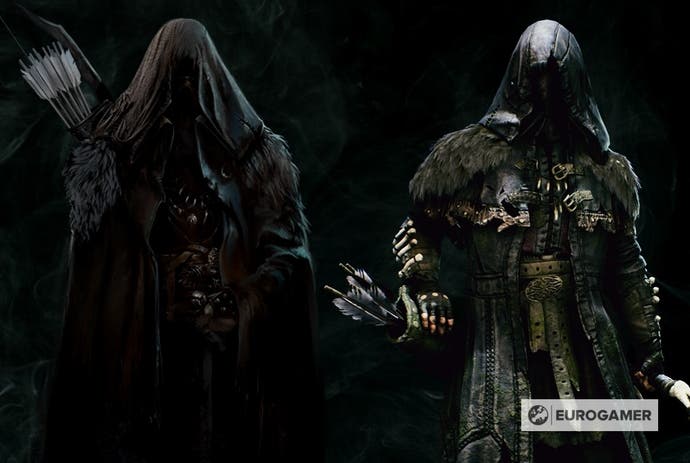
For us, our pedigree is in multiplayer games. So what we were really interested in is how can we take this and do a twist where it becomes more PvP? So we started off with a number of different concepts that we thought, 'Well this is the outlaws, the gang of Merry Men, basically trying to steal the treasure from the Sheriff of Nottingham and the evil powers that be. So what about if the players controlled the state?' So it was like the state had the riches, versus the outlaws, and one team's trying to protect the gold, the other team's trying to steal it. So a very traditional set-up.
And then, quite quickly, conversations went to something a little bit more innovative. We were playing a lot of games like Hunt: Showdown, a lot of PvPvE games, and there was a lot of interesting mechanics and interesting features about those games where we thought we could do something even better with it. We could put another twist on this. What about if it was two outlaw teams and they were both trying to steal the treasure?
And then you've got the environment. You've got the Sheriff, who then becomes like Mr. X from Resident Evil: a big-ass kind of tank that's stomping around that will instakill you, and this castle which is just full of AI. So you've got this kind of swarm AI, where you can get lots and lots of kills; doesn't have to be players but you're getting the good feels from getting headshots, right? And so that just started to take shape.
Then when we started really digging into the actual legends of Robin Hood, there were, bizarrely, two kinds of competing legends, which is Robin of Locksley, and Robin the Earl of Huntingdon. And that was just great. It was just written for us really. Like, 'Well there's our teams right there, Locksley and Huntington.'
When we dug into it, what was immediately obvious was [the mystery of] who was behind the hood was far more interesting than defining [it]. And that's where we ended up with the fantasy for the game. It was like the hood became a symbol to the people, a symbol of the people rising up against the power, almost like Anonymous, you know? So it was this idea that you'll never reveal the identity.
So we ended up using the themes of Locksley and Huntingdon just as team names, reds versus blue. We thought that was a nice fantasy. But what was most compelling about it was the idea that you'd have these two outlaw factions that were basically trying to steal the same gold. And one of the other things as a narrative touch-point for us was, you know how you always hear Robin Hood robbed from the rich to give to the poor? That's not actually true.
Oh no! You've just ruined my childhood.
Andrew Willans: [laughs] We thought we'd twist that a little bit, and it was actually Robin Hood robs from the rich to hurt the rich. And suddenly when you go out with a statement like that, you have a little bit more player agency. So we give you a decision. You rob from the rich, you have a pile of gold, what do you do with it? And that's why an important mechanic within the game is what we call the Scales of Justice where, after every heist, you'll have this scale and two pots, and one's for the people and one's for your pocket, and you distribute the gold between them.
So on the one side, if you're giving to the people, and you're generous Robin [...] then more stuff will become available in your Hideouts. You'll get better perks, you'll get more weapons and costumes within your forest hideout. [But] you need the money in your pocket to buy them. So mechanically it's the meta, in the short-term. And we thought, 'Well, that's just really interesting. We'll give that to the hands of the players.' So actually how you control the progression is a little bit more in your control, you know?
Thematically and mechanically, things worked out quite well.
So how true to the actual legends of Robin Hood are you? Presumably you've done a lot of research around it. What did you find out? Did anything surprise you?
Andrew Willans: Yeah: Maid Marian, when we dug around, just never existed.
You can't say that, it's Pancake Day! [It was Pancake Day in the UK when we spoke. Please don't make me explain why this reminds me of a British TV show called Maid Marian.]
Andrew Willans: We couldn't find anything like... There wasn't really a historic case. It seemed to be more like a lot of the other characters that we associate with the legend were made up. They were actually tales in themselves that were just slotted in.
Is that true for all of the people, like Little John...?
Andrew Willans: I think there were references to a John, a John Nailer/Naylor, but most of those, it wasn't particularly steeped in history. It was [that] over the years people had embellished the legends, and it just made for a better story, and for better movies as well.
We knew early on that we didn't want to do your typical damsel in distress, so we knew when it came to Marianne [loosely based around Maid Marian, the Hunter in the game], we wanted a character that was really empowering to play. Marianne is a badass Hunter. She's a brutal assassin really, but she's very streamlined.
She's the lady with the thing on her wrist [note my technicality here]?
Andrew Willans: Yes, yeah. So she's got a wrist-mounted crossbow, which is like a triple-shot crossbow, which has also got the blade on. She is incredibly agile. So with her it's all about getting in there and doing stealth takedowns, slitting throats in the dark. And John [based on Little John obviously] was a little bit easier because there's been a few different versions of John, but for our version-
John is the big guy?
Andrew Willans: Yeah, he's effectively our tank. We call him the Brawler, because they all have their classes. And our inspiration for that was really Mad Sweeney from American Gods.
I've never seen it!
Andrew Willans: Right! So Mad's a massive leprechaun, [with] ginger hair and a ginger beard. You can even see it in the character design. But it was that attitude of like, 'let's have some'. The guy who stood outside the pub and smashes the beer glass over his own head and then goes, 'Right, come on!' So that was beautiful, it just fit the character of John Nailer perfectly, this blacksmith who was really rebelling against the State.
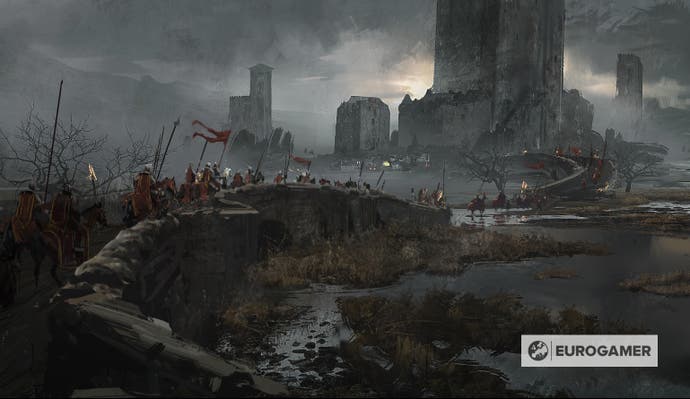
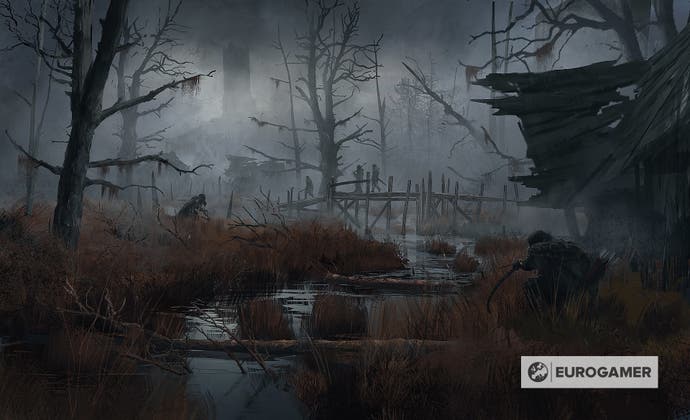

And then for Tuck [Friar Tuck obviously], we went a little bit further. Friar Tuck was always this religious figure, and there were a few different versions of him. We really liked the idea that he'd been an inquisitor within the State, so he's actually part of the system. So he was doing the bidding of the evil State. And then he had this realisation, this moment where he thought, 'Well fuck this, this is really corrupt. I want out,' and then disappeared. And then travelled the world, spent time with different religions and cultures, maybe spent a bit long in the forests and took too many mushrooms... And that gives him these kinds of ethereal powers, where he can put his hand into the soil and almost become one with the mycelial network - connect to the earth and get these interesting gifts. But at the same time, he's still a brutal melee character, because he's got an incense burner which also serves as a flail.
I wondered what that was!
Andrew Willans: Yeah, so he'll be walking down, almost looking shamanic, with his kind of incense burner, and then when he gets in a fight, suddenly it's like this far-extending flail that looks more like the chains from God of War.
So those are the four characters? And is it the same for both teams?
Andrew Willans: Yes, yeah. And then you've got a range of perks for all of the characters, you've got a range of costumes and weapons so that you customise them to, more than anything, match your playstyle, so they all serve a purpose.
We've got the Ranger, Robin, who is really - we equate him to being a sniper rifle. We've got Marianne, who is the Hunter, who, like I said, is really good at close-quarters and stealth takedowns. You've got John who's the Brawler, the tank who can lift heavy items. He can carry the chest quicker than anyone else, he can winch faster than anyone else when you're extracting. And then we've got Tuck who is a Healer, but is also a bit of a badass. He's more of a tactician as well. He's like a mystic class, so he can see enemies through walls and do all kinds of fun things. And that's the outlaw gang at launch.
With, obviously, scope to bring in new characters down the line?
Andrew Willans: Imagine that! As if we weren't sitting here designing the fifth one already. [Laughs]
Where's my Morgan Freeman?!
Andrew Willans: Exactly!
So the enemies you come up against: tell me about this Sheriff, who you said was like Resident Evil's Mr X.
Andrew Willans: He is actually an objective. So there's stages to a heist. The first stage is getting the key to the vault. Now, that vault key is on the belt of the Sheriff of Nottingham. So initially, both teams start at opposite ends of the map, [and] you've got to work your way through the environment, taking down people - hopefully sneakily - and then get to the Sheriff. Now, on your map, you'll have his patrol path marked, so you know roughly where he is, but you need a line of sight, then you need to creep up behind him and steal the key off his belt. Now, if he notices, you're in trouble! So his first purpose is really as a mobile objective.
Once you get that key, that key will give you a clue as to where the treasure is. You then need to head to one of the buildings that can house the treasure, find it, and open the treasure vault. Once you get in there, you pick up the treasure chest itself, and that needs to be physically carried to an extraction point. So that third phase is all about getting that heavy treasure chest to one of these winching devices. There's multiple locations [for this] so you decide where you want to extract from. You get that loaded up and then you operate a winch to, effectively, winch it to safety, to claim the loot.

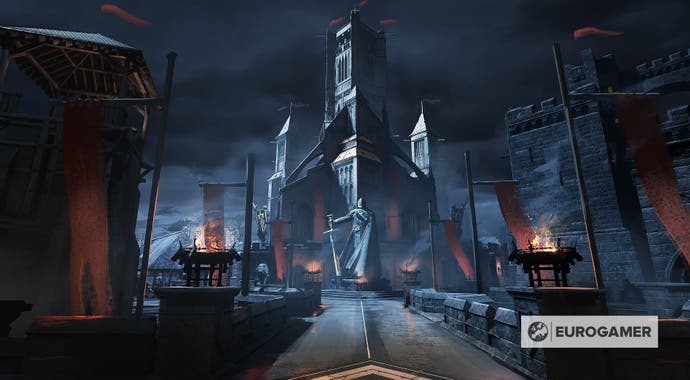
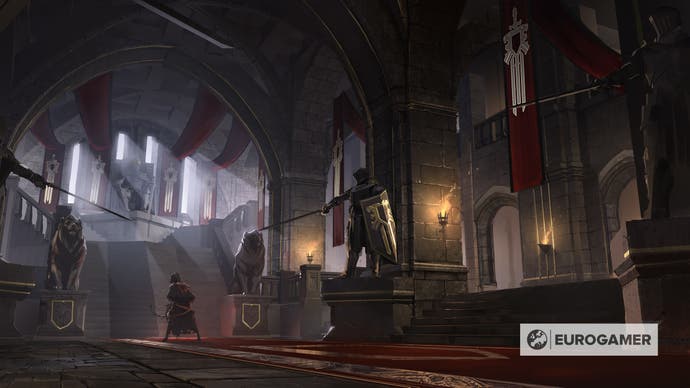
It's a bit of a MacGuffin, it's a very gamey thing. But what it also gives us is that perfect catch-up moment, where we find we have a lot of battles around the final third of the game.
The notion of it was the three-act structure of a heist. So you've got that perfect plan, perfectly executed, and then the getaway at the end where things get a bit more exciting because alarms are tripped and stuff like that. We have a number of game mechanics which all feed into that. So the Sheriff will start as a mobile objective. During the second phase, when you're getting the chest, it really depends on the player's actions as to what he's doing, because if players kite him to the chest and he sees it, he will defend it because that's his loot, right? So he will actively pursue anyone within range. In the third phase, as you're actually extracting that treasure, if you've tripped the alarms, we have a fully-fledged escalation system. So we go into what we call lockdown-
I know it well!
Andrew Willans: Oh god, yeah - it's too soon, too soon! And so when we enter this final phase, the Sheriff will just make his way to the treasure chest. So he knows, when the alarms are tripped, where it is. Then you have a battle at the extraction zone with the AI guards, with the Sheriff himself, and with the opposing team. And that's usually the most explosive part.
So, really, we're a stealth-action game, but the stealth is [only] really important in the first couple of stages. It's not so critical in the third stage. Usually, it gets a lot more exciting. So what you find is if you're playing a stealthy game, in the early part, it will set you up perfectly for the final third. So by playing stealthy and doing stealth-takedowns, you fill your ability meter, you're going to pick up some cool items, and hopefully that gets you to the point where you can get in, get the chest without the other team finding you, and then start winching. It is possible to complete the game entirely without being seen but that rarely happens. That's Ryan Gosling in Drive, right? That's the moment where he's just sitting in behind a van and it's the perfect getaway.
These ability metres you mentioned: I'm presuming they're a bit like Ultimate meters in Overwatch?
Andrew Willans: Absolutely, yeah, it passively ticks up. And if you do more stealth actions, if you do more assassinations, it will increase really quickly. So for every stealth-takedown you do, you'll get a big chunk. It's a subtle incentive to play stealthy. The other one is just not to kick the hornet's nest, so if you're going around making a lot of noise, the guards will react to you. And they will potentially try and trap you in areas and send in reinforcements. The castle is kind of alive, we like to think of it as almost a sentient castle, so once you get in those environments, they should feel dangerous.
What happens if you die?
Andrew Willans: Oh, you respawn. We have toyed with - and probably further down the line - a hardcore game mode with one life, but to do that, you need some really cool replay systems and spectator cams, which is something we'll probably look at post-launch. But the game design as it is now: you respawn.
So how long, roughly, is a match?
Andrew Willans: I would say our sweet spot is around the ten-to-fifteen minute mark. If you have a really skilled team, and it's a smaller map, you could potentially do it in five or six minutes. But likewise, it could take up to twenty-five minutes.
So presumably these maps are your way of telling a story, because there's no story mode, is there?
Andrew Willans: No. We have PvE so you can train in the maps, so that's something you can do with your friends. We have a lot of backstory tapestries which you can collect, which fill out a little bit about 'where did Tuck come from?', for example - a little bit about the characters and the world.
But you're absolutely right: we lean heavily on environmental storytelling, and that's why it was a huge challenge for us to get across the idea that the State are the villains. The idea that this corruption of church and state combined to crush the will of the common man. And that's why you'll see all of their buildings, that kind of towering architecture, displayed with dominance and power. This kind of [Soveit bloc] Brutalism.
Luc Fontenay [lead concept artist]: That was one of the pillars we had for our art direction from the start. We didn't really want to do that kind of classical medieval look. We ended up kind of veering towards this almost Brutalist [architecture], medieval style. So looking at these massive concrete structures and applying them to medieval castles. So we've got these really towering monoliths in the middle of a forest, or jutting out from the landscape. And I think that kind of helps convey this really cold, harsh mentality that the State has.
I imagine that was probably the desired effect even back then!
What you're doing reminds me of Overwatch and how Blizzard tells a story through the environments. Are you trying to do the same thing here or is it just grounding people in your kind of reality?
Andrew Willans: There is a wider narrative in the length and breadth of locations that we've used. So if you took just the legend of Robin Hood, you would say, 'Oh all right, we're going to play it in Sherwood Forest.'
Is there a Sherwood Forest map? There must be!
Andrew Willans: I couldn't possibly say! Coming soon, TM. [laughs]
But yeah, if we just took those legends, we'd just spend all our time in that one location. So what we've tried to do is look at the great and the good within the UK, because we've got some amazing castles, you know. Up north, we've got Bamburgh, Lindisfarne, Alnwick. Then, when you get further afield, we've got a Conwy down in Wales, you've got Edinburgh, you've got Dover castle as well. So we tried to take influence from those locations and biomes, rather than recreating bricks and mortar. But it's to make you feel like you've been on a journey, to make it feel bigger than just spending time in a forest. The idea that you've visited quite a lot of exotic locations within the UK.

We have a coastal map which was based loosely on some of those historical sites, like Dover, Lindisfarne and Bamburgh, but it's probably more influenced by things like the Iron Islands from Game of Thrones, or Dragonstone. Game of Thrones was a touch-base for us during development. We started off, at one point, with, 'What would it look like if Game of Thrones did Payday in a Robin Hood universe?' That was one of the things we smashed together. So you'll see a lot of that. We have a map that's set in some marshlands. That was totally influenced by an image from Game of Thrones. Was that one from Battle of the Bastards, Luc? Can you remember?
Luc Fontenay: It was, yeah.
That was a wonderful episode!
Andrew Willans: So good, yeah.
So did looking around the UK give you an opportunity to pull in other folklore, similar to how Assassin's Creed Valhalla has done, and rather successfully?
Andrew Willans: Not so much, really. We didn't get stuck on any one legend. It was more just the feel of locations. Where we started was really just the biomes, more than anything else, for variety. I know it sounds like almost like a gaming trope, like lava level, snow level-
But it's important! Particularly when you're replaying the levels.
Andrew Willans: Absolutely. [...] One of the biggest challenges we actually faced was just not setting everything at night. It's a stealth game, and we were like, 'Oh fuck, we've got all these maps, they can't all be at night! It's gonna be one note.' So we explored lots of interesting ways to bring in that contrast between the light and the dark. So we have a map that's set in a graveyard, but it's actually quite bright sunlight. But that creates this lovely contrast, with really dark, long shadows that you can hide in. It's almost like you have got these elements of pitch-black to sit in, in the corners, and snipe from or assassinate from.
And then Outpost is a dawn map, so we've got that rising sun, which, again, is that strong light, which creates those directional shadows, which helps. And then our main nighttime map - I think it's the only one that's fully at night - is in Citadel, which is like the heart of the State. And that gave us a chance to really go full ham on the pantomime villain! That's the most brutal architecture in the game, the Citadel. It's one of our bigger maps. And it's really striking to see all of this huge towering concrete lined with gold and the blood-red flags, but at night. And of course, all of the light there is by torchlight, which creates a totally different vibe again.
What was the Hideout you mentioned earlier? A sort of place you inhabit between matches?
Andrew Willans: Yeah, it's a safe space really. I mean, for all intents and purposes it's a lobby. It's a place where all the shops are, so you've got your character progression, you've got challenges, you've got perks for your character, which you can unlock and craft. You've got your weapons, you've got your cosmetics, and there's a training range so you can practice shooting, you can practice in gear items, or hitting melee mannequins. And you can invite your friends to join you as well. So a team of four can just have a bit of fun.
Is it a place you can customise in any way?
Andrew Willans: No. We did toy with the idea that you could upgrade the Hideout, that the spoils of your riches would have an effect on this area, but it was just a lot of development time for something which didn't really give much in terms of gameplay.
Basically it's a nice forest dwelling, a Hideout for you to chill out between matches.
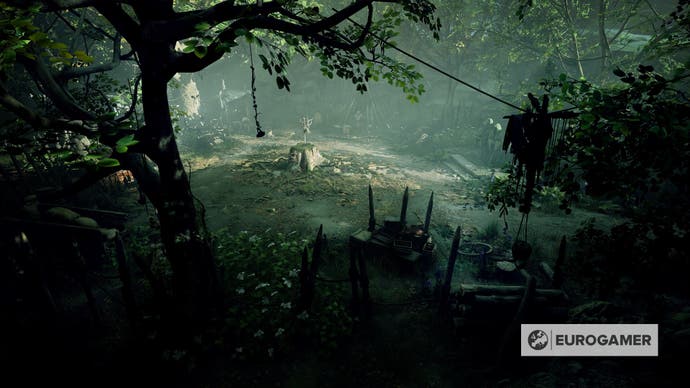
And the things you unlock or buy there, like perks and equipment, does all that mean we'll be permanently improving our characters there?
Andrew Willans: Yeah, but we deliberately didn't want to go for a min-maxing thing. There's nothing worse than you just grind your way through and unlock all these things, and you've got more power. So it's more up to you to customise the playstyle to your liking. Robin, he's a good example. So his arrows, when you shoot someone, when you loose an arrow and you kill someone: there is a chance that that arrow will break. But there's also a chance that it's going to stick in the body, so you can run over and pick the arrow off the corpse and put it in your quiver and reuse it. Now, there is a perk in there that will give you a hundred per cent chance of breakage, so that arrow is gone, but it increases the damage that the arrow does. There's always little trade-offs with each of the perks.
So there's no levelling as it were, no getting passively more powerful?
Andrew Willans: No, no. There's always a danger with multiplayer, with PvP games especially, that you run the risk of leaving people behind. We always wanted it [that] if I pick that pad up tomorrow and play with someone that's rank ninety-nine and has been playing for a year, we're still competitive. It's just he might have customised lots more things than I have, and obviously be a lot more used to the game than I am! But it still feels like a level playing field.
And is all this progression tied to the account or per character?
Andrew Willans: Each character has their own rank, so they have a level, and the more XP you earn with that character, by playing the character, then the higher that rank is, and that gates the perk progression. The more you use the character, the more perks are available. But that's all feeding into one pool of XP for you, so you have an overall badass reputation rank. You, as a player, is the combined XP of all of those characters used.
Okay. And the equipment we buy, does that give any statistical bonuses or is it all cosmetic?
Andrew Willans: Absolutely cosmetic. Some of them look radically different, but yeah, they're all just cosmetics.
Okay! So, release is set for this year, in May?
Andrew Willans: Yes, the 10th of May. And there's early access for people that pre-order.
And it's coming out for last-generation consoles and current generation consoles at the same time?
Andrew Willans: Yeah, absolutely. We're shipping on all console platforms except for Switch - I have to throw that in there. So we're doing PS4 and all of the Xbox Ones, and then obviously the new boys, which we optimise for. We do have full cross-play in there, [and] it's up to you to opt in and out of. We're obviously targeting 60fps and lovely visual fidelity on our new consoles, but for obvious reasons we'll probably have to do 30fps on [last-gen machines], depending on how we optimise.
Andrew Willans, thank you very much.



